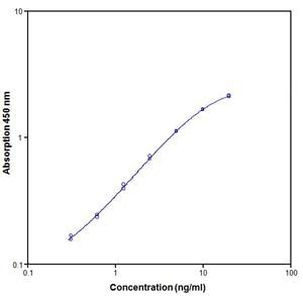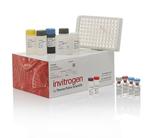Search Thermo Fisher Scientific
产品规格
检测灵敏度
测定范围
检测样本类型/体积
手工操作时间
总时间
均相(无需洗涤)
批间差异
批内差异
检测仪器
产品规格
产品成分
Standard
Sample Diluent
Assay Buffer concentrate
Biotinylated Detection Antibody
SAV-HRP
Wash Buffer
Chromogen
Stop Solution
Adhesive Plate Covers
运输条件
储存
蛋白名称
均相(无需洗涤)
检测试剂盒格式
检测抗体结合物
标签或染料
关于本试剂盒
The Human Fibronectin ELISA quantitates Hu Fibronectin in human serum, plasma, urine or cell culture medium. The assay will exclusively recognize both natural and recombinant Hu Fibronectin.
原理方法
The Human Fibronectin solid-phase sandwich ELISA (enzyme-linked immunosorbent assay) is designed to measure the amount of the target bound between a matched antibody pair. A target-specific antibody has been pre-coated in the wells of the supplied microplate. Samples, standards, or controls are then added into these wells and bind to the immobilized (capture) antibody. The sandwich is formed by the addition of the second (detector) antibody, a substrate solution is added that reacts with the enzyme-antibody-target complex to produce measurable signal. The intensity of this signal is directly proportional to the concentration of target present in the original specimen.
严格验证
Each manufactured lot of this ELISA kit is quality tested for criteria such as sensitivity, specificity, precision, and lot-to-lot consistency. See manual for more information on validation.
Fibronectin is a disulfide-bonded dimer with a molecular weight range of 230-250 kDa. In the extracellular matrix of several connective tissues and vessels, fibronectin is present as an insoluble protein that is extensively cross-linked by interchain disulfide bonds forming high molecular mass polymers. Fibronectin is most abundant during embryonic development and tissue remodeling. Fibronectin is also present at high concentrations as a soluble plasma protein. Fibronectin is organized as a linear series of repeating modules which form domains for interaction with fibronectin itself, other matrix components (e.g. collagen and heparin) and receptors on cells (e.g. integrins). Fibronectin is present in a soluble dimeric form in plasma, and in a dimeric or multimeric form at the cell surface and in extracellular matrix. Fibronectin is involved in cell adhesion and migration processes including embryogenesis, wound healing, blood coagulation, host defense, and metastasis. Fibronectin has been implicated in carcinoma development in lung cancer. Further, Fibronectin expression is increased especially in non-small cell lung carcinoma. The adhesion of lung carcinoma cells to Fibronectin enhances tumorgenecity and confers resistance to apoptosis induced by standard chemotherapeutic agents. The gene encoding Fibronectin has three regions subject to alternative splicing, with the potential to produce 20 different transcript variants. However, the full-length nature of some Fibronectin variants has not been determined.
仅用于科研。不用于诊断过程。未经明确授权不得转售。
生物信息学
基因别名 : CIG, ED-B, FINC, FN, FN1, FNZ, GFND, GFND2, LETS, MSF
基因ID : (Human) 2335
基因符号 : FN1
蛋白别名 : CIG, Cold-insoluble globulin, Fibronectin, FN, migration-stimulating factor
UniProt ID (Human) P02751





